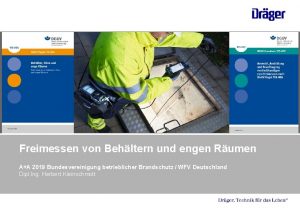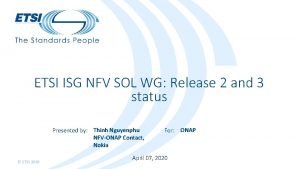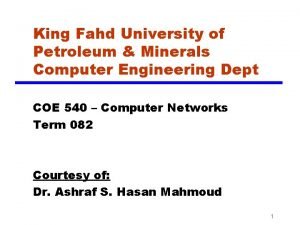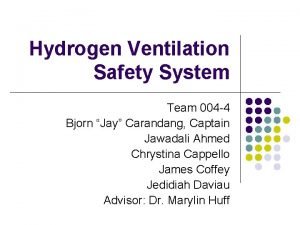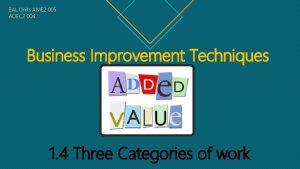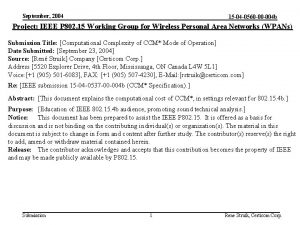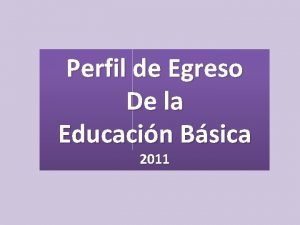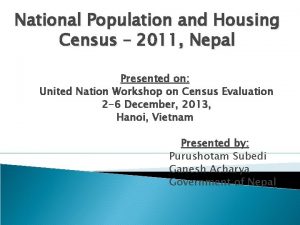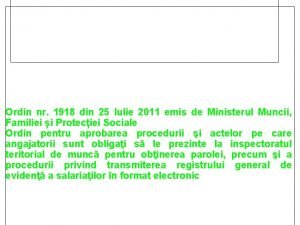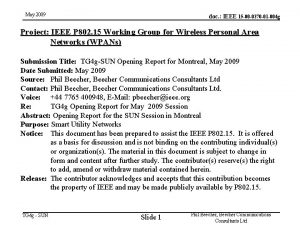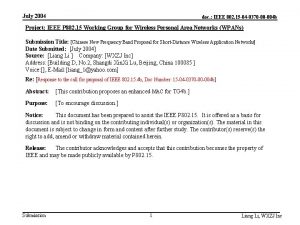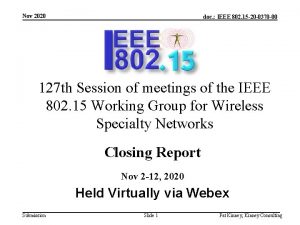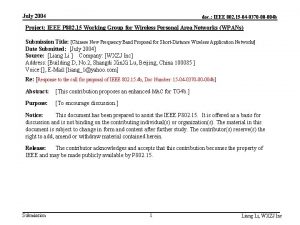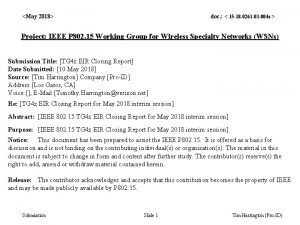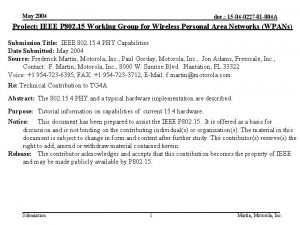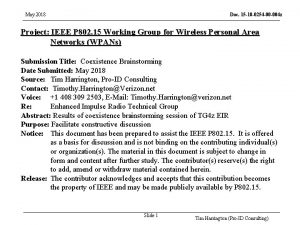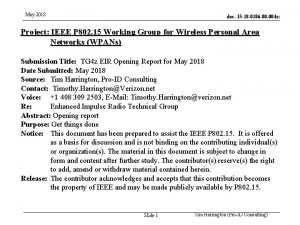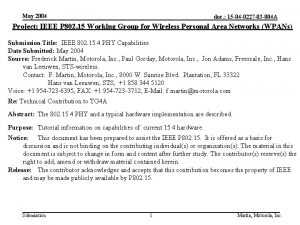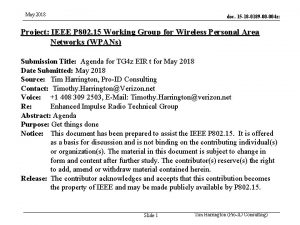May 2011 doc 15 11 0370 00 004













- Slides: 13

<May 2011> doc. : <15 -11 -0370 -00 -004 k> Project: IEEE P 802. 15 Working Group for Wireless Personal Area Networks (WPANs) Submission Title: [TG 4 k Opening Report for May 2011 Session] Date Submitted: [8 May 2011] Source: [Patrick Kinney] Company [Kinney Consulting LLC] Address [Chicago area, IL, USA] Voice: [+1. 847. 960. 3715], E-Mail: [pat. kinney@ieee. org] Re: [TG 4 k Opening Report for May 2011 Session. ] Abstract: [Opening Report for the May TG 4 k Session] Purpose: [PHY Amendment to IEEE 802. 15. 4] Notice: This document has been prepared to assist the IEEE P 802. 15. It is offered as a basis for discussion and is not binding on the contributing individual(s) or organization(s). The material in this document is subject to change in form and content after further study. The contributor(s) reserve(s) the right to add, amend or withdraw material contained herein. Release: The contributor acknowledges and accepts that this contribution becomes the property of IEEE and may be made publicly available by P 802. 15. Submission Slide 1 <Pat Kinney>, <Kinney

<May 2011> doc. : <15 -11 -0370 -00 -004 k> TG 4 k PAR Scope of Proposed Standard This standard is an amendment to IEEE 802. 15. 4. It addresses principally those applications such as critical infrastructure monitoring. It defines an alternate PHY and only those MAC modifications needed to support its implementation. The amendment supports: • • Operation in any of the regionally available licensed, license exempt, and special purpose frequency bands. Simultaneous operation for at least 8 co-located orthogonal networks Application data rate of less than 40 kbits per second Propagation path loss of at least 120 d. B > 1000 endpoints per mains powered infrastructure Asymmetric application data flow Extreme difference in capabilities and performance between endpoint devices and coordinating devices (collectors) – Coordinator may support all standardized modulations (MCS) and data rates – Coordinator may be required to support antenna diversity or antenna beam steering – End point must be able to conserve energy • Reliable operation in dramatically changing environments (no control over environment). This amendment also provides mechanisms that enable coexistence with other systems in the same band(s) including IEEE 802. 11, 802. 15, and 802. 16 systems Submission Slide 2 <Pat Kinney>, <Kinney

<May 2011> doc. : <15 -11 -0370 -00 -004 k> Purpose of Proposed Standard The purpose of this amendment is to facilitate point to multithousands of points communications for critical infrastructure monitoring devices. The amendment addresses the application’s user needs of minimal network infrastructure, and enables the collection of scheduled and event data from a large number of non-mains powered end points that are widely dispersed, or are in challenging propagation environments. To facilitate low energy operation necessary for multi-year battery life, the amendment minimizes network maintenance traffic and device wake durations. In addition, the amendment addresses the changing propagation and interference environments. Submission Slide 3 <Pat Kinney>, <Kinney

<May 2011> doc. : <15 -11 -0370 -00 -004 k> Meeting Goals q Hear application presentations q Draft and approve Technical Guideline Document (TGD) q Draft and approve Call for Proposals (CFP) q Draft Coexistence Criteria document Submission Slide 4 <Pat Kinney>, <Kinney

<May 2011> doc. : <15 -11 -0370 -00 -004 k> TG 4 k Meetings This Week Mtg Monday AM 1 AM 2 Opening Logistics, Application presentations Tuesday Wednesday Thursday Draft TGD and CFP Approve TGD and CFP, closing report, adjourn Draft TGD and CFP PM 1 PM 2 Submission Slide 5 <Pat Kinney>, <Kinney

<May 2011> Instructions for the WG Chair doc. : <15 -11 -0370 -00 -004 k> The IEEE-SA strongly recommends that at each WG meeting the chair or a designee: – Show slides #1 through #4 of this presentation – Advise the WG attendees that: • The IEEE’s patent policy is consistent with the ANSI patent policy and is described in Clause 6 of the IEEE-SA Standards Board Bylaws; • Early identification of patent claims which may be essential for the use of standards under development is strongly encouraged; • There may be Essential Patent Claims of which the IEEE is not aware. Additionally, neither the IEEE, the WG, nor the WG chair can ensure the accuracy or completeness of any assurance or whether any such assurance is, in fact, of a Patent Claim that is essential for the use of the standard under development. – Instruct the WG Secretary to record in the minutes of the relevant WG meeting: • That the foregoing information was provided and that slides 1 through 4 (and this slide 0, if applicable) were shown; • That the chair or designee provided an opportunity for participants to identify patent claim(s)/patent application claim(s) and/or the holder of patent claim(s)/patent application claim(s) of which the participant is personally aware and that may be essential for the use of that standard • Any responses that were given, specifically the patent claim(s)/patent application claim(s) and/or the holder of the patent claim(s)/patent application claim(s) that were identified (if any) and by whom. – The WG Chair shall ensure that a request is made to any identified holders of potential essential patent claim(s) to complete and submit a Letter of Assurance. – It is recommended that the WG chair review the guidance in IEEE-SA Standards Board Operations Manual 6. 3. 5 and in FAQs 12 and 12 a on inclusion of potential Essential Patent Claims by incorporation or by reference. Note: WG includes Working Groups, Task Groups, and other standards-developing committees with a PAR approved by the IEEE-SA Standards Board. Submission Slide 6 <Pat Kinney>, <Kinney

<May 2011> doc. : <15 -11 -0370 -00 -004 k> Participants, Patents, and Duty to Inform All participants in this meeting have certain obligations under the IEEE-SA Patent Policy. Participants: l “Shall inform the IEEE (or cause the IEEE to be informed)” of the identity of each “holder of any potential Essential Patent Claims of which they are personally aware” if the claims are owned or controlled by the participant or the entity the participant is from, employed by, or otherwise represents l “Personal awareness” means that the participant “is personally aware that the holder may have a potential Essential Patent Claim, ” even if the participant is not personally aware of the specific patents or patent claims “Should inform the IEEE (or cause the IEEE to be informed)” of the identity of “any other holders of such potential Essential Patent Claims” (that is, third parties that are not affiliated with the participant, with the participant’s employer, or with anyone else that the participant is from or otherwise represents) l The above does not apply if the patent claim is already the subject of an Accepted Letter of Assurance that applies to the proposed standard(s) under consideration by this group Quoted text excerpted from IEEE-SA Standards Board Bylaws subclause 6. 2 Early identification of holders of potential Essential Patent Claims is strongly encouraged Slide #1 No duty to perform a patent search l l l Submission Slide 7 <Pat Kinney>, <Kinney

<May 2011> doc. : <15 -11 -0370 -00 -004 k> Patent Related Links All participants should be familiar with their obligations under the IEEE-SA Policies & Procedures for standards development. Patent Policy is stated in these sources: IEEE-SA Standards Boards Bylaws http: //standards. ieee. org/guides/bylaws/sect 6 -7. html#6 IEEE-SA Standards Board Operations Manual http: //standards. ieee. org/guides/opman/sect 6. html#6. 3 Material about the patent policy is available at http: //standards. ieee. org/board/pat-material. html If you have questions, contact the IEEE-SA Standards Board Patent Committee Administrator at patcom@ieee. org or visit http: //standards. ieee. org/board/pat/index. html This slide set is available at http: //standards. ieee. org/board/pat-slideset. ppt Slide #2 Submission Slide 8 <Pat Kinney>, <Kinney

<May 2011> doc. : <15 -11 -0370 -00 -004 k> Call for Potentially Essential Patents • If anyone in this meeting is personally aware of the holder of any patent claims that are potentially essential to implementation of the proposed standard(s) under consideration by this group and that are not already the subject of an Accepted Letter of Assurance: – Either speak up now or – Provide the chair of this group with the identity of the holder(s) of any and all such claims as soon as possible or – Cause an LOA to be submitted Slide #3 Submission Slide 9 <Pat Kinney>, <Kinney

<May 2011> doc. : <15 -11 -0370 -00 -004 k> Other Guidelines for IEEE WG Meetings l All IEEE-SA standards meetings shall be conducted in compliance with all applicable laws, including antitrust and competition laws. l l Don’t discuss the interpretation, validity, or essentiality of patents/patent claims. Don’t discuss specific license rates, terms, or conditions. l Relative costs, including licensing costs of essential patent claims, of different technical approaches may be discussed in standards development meetings. l l Technical considerations remain primary focus Don’t discuss or engage in the fixing of product prices, allocation of customers, or division of sales markets. l Don’t discuss the status or substance of ongoing or threatened litigation. l Don’t be silent if inappropriate topics are discussed … do formally object. -------------------------------- See IEEE-SA Standards Board Operations Manual, clause 5. 3. 10 and “Promoting Competition and Innovation: What You Need to Know about the IEEE Standards Association's Antitrust and Competition Policy ” for more details. Slide #4 Submission Slide 10 <Pat Kinney>, <Kinney

<May 2011> doc. : <15 -11 -0370 -00 -004 k> TG 4 k Officers Chair: Patrick Kinney Vice Chair: TBD Secretary: Betty Zhao Technical Editor TBD Submission Slide 11 <Pat Kinney>, <Kinney

<May 2011> Chair’s Role doc. : <15 -11 -0370 -00 -004 k> • http: //ieee 802. org/Mike_Spring_Article_on_Stds_ Process. pdf …the chairperson of the working group is key to what and how fast a standard is produced. The chair of the committee acts as a facilitator with little power to legislate. The chair must be knowledgeable about the subject but also know how a standard may be used by various segments of the industry. A chairperson should be a leader-diplomat-observer, in equal proportions. Also, the chairperson should not be a doer, perfectionist or obstructionist. This is consistent with the view of the chairperson as a skilled leader with strong negotiation skills who delegates. Submission Slide 12 <Pat Kinney>, <Kinney

<May 2011> doc. : <15 -11 -0370 -00 -004 k> TG 4 k Schedule • Proposal Effort – – – Technical Guidance Document Call for Proposals Preliminary Proposals Final Proposals Adopt Baseline May 2011 July 2011 Sep 2011 Nov 2011 • Drafting – Preliminary draft – Final draft (ready for WG Letter Ballot) May 2012 July 2012 • Balloting – – – Letter ballot Recirculation III Sponsor Ballot Submission Sep 2012 Jan 2013 Mar 2013 May 2013 July 2013 Slide 13 <Pat Kinney>, <Kinney

